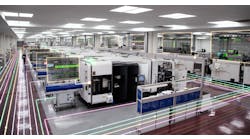Today’s Computer Aided Machining (CAM) software packages can be divided into two types.
One type strives to make it as easy as possible for machinists to quickly generate CNC toolpaths with minimal input.
The second type is designed to provide a powerful toolkit for experienced machinists who know exactly how they want to machine a particular part.
Delcam Plc’s (www.delcam.com) PowerMill package is the second type, and a new version about to be released offers its users a more complete solution for complex machining operations, together with more control for experienced machinists. The software also includes a range of enhancements to existing functionality to enable both faster programming and faster machining.
“Ever since its first release, PowerMILL has focused on the more complex parts of any manufacturing operation,” Delcam’s CAM Development Director Steve Hobbs said.
“Many of our toolmaking customers tend to program the simpler tasks, like sizing the starting block of material, and finishing operations, such as cutting off, on the machine tool control rather than by off-line programming. However, as we have become more established in production machining, a growing number of our customers want to program everything with their CAM system. This has always been possible in PowerMILL, but the new options in PowerMILL 9 will make the complete programming process much easier,” he added.
Using a completely offline approach to programming gives other benefits as well.
It ensures that a fully detailed record is maintained of the whole manufacturing process. This makes it easier for jobs to be repeated by different staff, or even at different locations, and will ensure a consistent approach is maintained whenever and wherever a part is produced.
Also, it makes simulation of the complete process easier and more reliable. The simulation can begin from the starting block of material, rather than the user having to produce a model of the stock remaining after the manually programmed operations have been completed.
Recent development of PowerMILL has focused on making it easier for inexperienced and casual users to generate high-quality toolpaths for high-speed and five-axis machines tools.
However, very experienced users tend to know exactly how they want to manufacture a particular part, or undertake a particular operation. They need greater control over the results that their software can give to achieve maximum productivity, even if this requires more skill and experience with the program.
PowerMILL 9 offers them this control by making it easier for experienced users to generate toolpaths based on any 3D curve. This was possible previously using PowerMILL’s pattern machining commands, but the new approach makes it easier both to create the required 3D curve and to drive the cutter along it.
The new version includes a range of enhancements to give faster programming and faster machining.
“Originally, many customers would buy PowerMILL simply because it was the only CAM system that could machine their components or tooling. While there are other CAM systems that can be used to manufacture complex parts, we believe these cannot match the speed and quality of both programming and machining that our customers can achieve with PowerMILL,” Hobbs said.
PowerMILL 9 also incorporates improvements designed to reduce calculation times, together with some simplification of the user interface, that makes it easier to select the required command. In addition, toolpath ordering has been made more efficient, especially for roughing and rest machining, ensuring that the cutter spends more time machining and minimal time making air moves.
“These enhancements may not grab as many headlines as completely new machining strategies. However, they are vital to our customers that need to increase their productivity and reduce their lead times to maximize their competitiveness,” Hobbs said.






